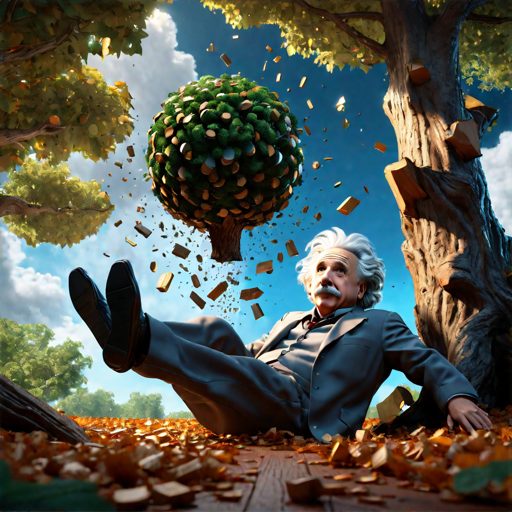
Gravity – Why down and not up – Einstein’s Insight!
Recommended for Gravity
In our universe, gravity stands out as a captivating force. Daily, we experience its pull, yet its true nature often remains unappreciated. Curious about why gravity pulls us down, not up? Let’s explore Einstein’s groundbreaking insight.
Synonymous with genius, Albert Einstein revolutionized our grasp of gravity in 1915. His theory of general relativity shifted our view, revealing gravity as a result of spacetime’s curvature. Consequently, we now perceive gravity not just as a force, but as a fundamental interaction within our universe.
Listen to the news
Einstein’s Revolutionary Perspective
Theory of General Relativity
- In 1915, Albert Einstein introduced the theory of general relativity, reshaping how we understand gravity. Previously viewed as a simple force, Einstein’s theory redefined it as a result of spacetime curvature. Imagine how a bowling ball placed on a trampoline warps the fabric around it. This is akin to how mass warps spacetime, creating what we experience as gravity.
- In other words, In 1915, Albert Einstein explained that gravity happens because objects with mass, like planets, bend the space and time around them, just like a heavy bowling ball bends the surface of a trampoline.
Gravity and Spacetime Interaction
- Einstein’s theory posits that spacetime, a fusion of the three spatial dimensions with time, is dynamic, responding to mass and energy. For instance, the Earth’s mass bends spacetime, pulling objects toward it, similar to objects rolling towards a heavier weight on a stretched cloth.
The Mechanics of Spacetime Curvature
Understanding Spacetime Curvature
- Spacetime curvature is at the heart of gravitational force. Objects, including us, are drawn towards the center of this curvature, known as a gravity well. It’s like how objects in water flow towards a drain; in a similar manner, we are drawn towards Earth’s center due to its gravitational pull.
Wells vs. Gravity Hills
- In reality, all matter creates gravity wells, not hills. This means gravity consistently pulls, rather than pushes, objects towards massive bodies. It’s like a marble rolling towards the lowest point in a bowl rather than being pushed up the sides.
- Imagine dropping a marble into a bowl. The marble naturally rolls down towards the bowl’s center, not up the sides. This is like how gravity pulls everything towards large objects like Earth, creating a ‘gravity well’, not a ‘hill’.
Implications of Gravity in the Universe and on Earth
Gravity’s Relationship with Mass
- The strength of gravitational force is directly linked to an object’s mass. Larger bodies like the Sun or black holes create deeper gravitational wells, explaining why planets orbit stars and the intense gravity of black holes. Picture how a large magnet can attract more or larger metallic objects compared to a smaller magnet.
Time Dilation:
- A fascinating outcome of gravity, as per Einstein’s theory, is time dilation. Near massive bodies where spacetime curvature is stronger, time progresses more slowly. This phenomenon was vividly depicted in the movie ‘Interstellar,’ where characters near a black hole aged slower than those in less curved spacetime.
The Earth’s Gravity Well
- Earth’s gravitational force offers a balanced example of a gravity well. It’s strong enough to anchor us and sustain our atmosphere, yet not excessively strong to be detrimental to life. This delicate balance is akin to a well-designed park, where the landscape is contoured just enough for enjoyment without being overwhelming or dangerous.
Reflection
Understanding gravity, not merely as a force but as the curvature of spacetime, significantly enhances our understanding of the universe. Consequently, Einstein’s theory of general relativity does more than just explain why gravity pulls us down; it also unlocks a world of intriguing phenomena such as black holes and gravitational waves.
Furthermore, as we delve deeper into our cosmic exploration, the concept of Earth Gravity continues to be an essential and remarkable element of our journey through space.
Therefore, let’s appreciate and persist in our quest to understand this incredible force that not only grounds us firmly on Earth but also inspires us to gaze upward at the stars.
Curious Times is a leading newspaper and website for kids. We publish daily global news aligned to your learning levels (also as per NEP 2020): Foundational, Preparatory (Primary), Middle and Senior. So, check out the News tab for this. We bring kids’ favourite Curious Times Weekly newspaper every weekend with top news, feature stories and kids’ contributions.
Curious Times News Program for Schools for FREE. Over 5,000 schools and teachers from all over the world have joined our programme so that students and teachers can get FREE Educative Newspaper. Here, kids can take part in world events and win prizes and certificates for free through their schools.
The following social media platforms allow you to communicate with us: Instagram.
0 (Please login to give a Curious Clap to your friend.)
